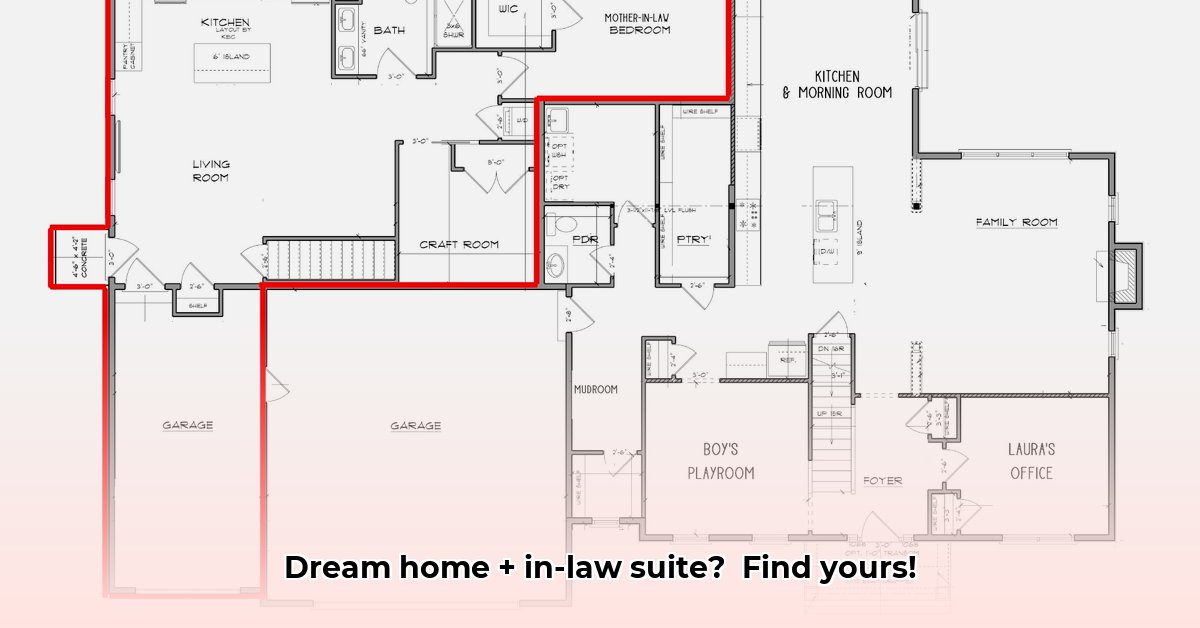Are you considering a home where you can live closer to family? In-law suites are growing in popularity, and for good reason! This guide walks you through the essentials of designing, building, or buying a house with an in-law suite. We’ll explore the advantages, design options, costs, and accessibility considerations to help you create the perfect multigenerational living space. For more in-depth multigenerational home planning, check out this helpful resource: Multi-Generational House Plans.
House with In-Law Suite Plans: Your Guide to Multigenerational Harmony
Building a home with an in-law suite blends family togetherness with individual space. This guide navigates considerations from initial design to budgeting. Let’s explore multigenerational home dynamics and what you should consider.
The Rise of Multigenerational Living
More families are discovering the benefits of multigenerational living. Sharing a home with extended family offers numerous advantages. Splitting utility bills, groceries, and mortgage payments eases the financial load. Grandparents helping with childcare and adult children assisting with household tasks strengthens family bonds and creates a built-in support system. House plans with in-law suites provide a housing solution that benefits everyone.
Designing Your In-Law Suite: Space, Privacy, and Accessibility
Designing the ideal in-law suite requires careful consideration of location, size, privacy, and accessibility. Where will it be situated on your property? What square footage is needed? How much privacy is desired? Will the occupants require specific accommodations? Let’s explore the home design, suite layout, and privacy considerations.
Location: A first-floor suite offers unparalleled convenience, especially for elderly parents or individuals with mobility challenges. Eliminating stairs ensures easy movement. However, this arrangement might compromise some privacy. A second-floor suite offers more seclusion, creating a more independent living space. If mobility is a concern, consider installing a stairlift. A detached guest house offers maximum privacy and independence, feeling like a separate apartment. Which layout best suits your family’s needs and preferences? This option often comes with a higher initial cost and increased maintenance.
Size and Layout: The suite should comfortably accommodate residents. A minimum should include a bedroom, bathroom, and living area. Including a kitchenette, laundry facilities, and ample storage space promotes self-sufficiency. How can you tailor the layout to their lifestyle and needs? An active individual will have different requirements than someone who prefers a quiet environment.
Privacy and Shared Spaces: Balancing privacy and togetherness requires strategically placing doors, hallways, and shared spaces. Ensuring the suite has its own entrance minimizes unnecessary interactions while still allowing for family gatherings. Shared outdoor spaces, such as a patio or garden, can bridge the gap between separate living areas. Strategic placement of doors can improve privacy and togetherness for the family.
Accessibility Features: If the in-law suite will house elderly parents or people with mobility challenges, accessibility is paramount. Design with wider doorways (at least 36 inches), roll-in showers, grab bars in bathrooms, and lever-style door handles. Consider the placement of electrical outlets and light switches for easy reach. Non-slip flooring is also a must. What proactive planning can prevent costly renovations later?
Building Codes and Regulations: Before finalizing floor plans, check local building codes and zoning regulations. These determine minimum square footage requirements, accessibility standards, and parking needs. Ignoring these rules can lead to delays, fines, and costly changes during construction.
The Financial Aspects of Building an In-Law Suite
Adding an in-law suite represents a significant financial investment. The cost varies depending on the design, size, materials used, and location. Converting an existing space, such as a finished basement or attic, is typically more budget-friendly than building a new addition. Account for materials, labor, permits, inspections, and upgrades to the existing home’s infrastructure.
Getting Precise Estimates: Secure multiple bids from reputable contractors and architects to compare proposals, understand the range of costs, and identify potential hidden expenses. Don’t hesitate to ask questions and clarify details in the contract. Obtaining a detailed breakdown of the work and the associated costs will provide a clear picture of your investment.
Resale Value and Long-Term Costs: A well-designed in-law suite increases a home’s resale value, especially in markets with high demand for multigenerational housing. Also, consider the potential cost savings compared to alternative arrangements like assisted living facilities.
Making Your Dream a Reality: A Step-by-Step Guide
Building or renovating a home to include an in-law suite is a substantial undertaking. Follow these steps:
-
Planning Phase: Define your needs, preferences, and budget. Research different layouts and designs. Consult with architects and contractors. Obtain multiple bids for your project.
-
Design Phase: Work with an architect or designer to finalize the plans, ensuring they adhere to building codes and your family’s needs. Consider future needs and potential design modifications.
-
Permitting and Approvals: Obtain all necessary building permits and approvals from your local authorities. This can take time, so apply early in the process.
-
Construction or Renovation: Hire experienced and trustworthy contractors to handle construction or renovation. Regularly monitor the progress of your project and maintain open communication with the contractors.
-
Final Inspection and Move-In: Once the work is complete, schedule a final inspection to ensure everything meets the necessary standards. Then, welcome your family to their new home!
Building or renovating an in-law suite is a substantial investment, but with careful planning, thorough research, and skilled professionals, it becomes a rewarding undertaking that benefits your entire family for years.
How to Maximize Resale Value of Homes with In-Law Suites
Key Takeaways:
- Adding an accessory dwelling unit (ADU) or in-law suite can significantly boost your home’s market value, especially in competitive housing markets.
- Rental income from the ADU can offset construction costs, improving the overall return on investment.
- Strategic design choices—size, layout, privacy features, accessibility—maximize usability and appeal to a broader range of buyers.
Design Choices: Crafting the Perfect In-Law Suite
Smart design maximizes your investment. The location of your in-law suite matters. A first-floor suite offers accessibility, while a second-floor suite provides more privacy. A detached structure offers the best separation.
Consider size. Cramped spaces will deter buyers. Aim for a comfortable layout with a separate entrance, full kitchen, and bathroom for maximum appeal. Privacy is essential. Soundproofing, separate entrances, and distinct outdoor spaces enhance desirability. Accessibility features such as ramps, widened doorways, and roll-in showers broaden your potential buyer pool and maximize value.
Navigating the Financial Landscape: Budgeting and ROI
Building an in-law suite is an investment. Obtain multiple contractor bids because costs vary based on size, materials, and location. Don’t forget permits and inspections. The increased property value frequently outweighs the initial expenses, and rental income can significantly offset construction costs, especially in areas with high housing demand.
Maximizing Your Return: Marketing and Appraisal
Smart marketing involves highlighting the suite’s versatility. Is it an ideal space for aging parents, a rental unit for extra income, or a home office? Appeal to various lifestyles with professional photos and compelling descriptions emphasizing the benefits.
Get an accurate appraisal. The valuation depends on the local market, the ADU’s features, and whether it’s rented or owner-occupied. Your agent should be knowledgeable about ADU valuations in your area.
Legal and Regulatory Considerations: Zoning and Permits
Before planning your in-law suite, familiarize yourself with local laws. Zoning regulations might restrict size, location, or building an ADU. Secure all necessary permits to protect your investment and future resale.
Designing Accessible In-Law Suites for Aging Parents
Key Takeaways:
- Multigenerational living is increasingly popular, driving demand for in-law suites.
- Designing accessible in-law suites for aging parents requires careful consideration of design, accessibility features, and budget.
- Location, size, and layout significantly impact functionality and cost.
Planning Your Accessible In-Law Suite: Location
The first step in designing accessible in-law suites for aging parents is choosing the right location. Do you have an existing space that could be converted, such as a basement or garage, or are you planning a new addition? A first-floor suite offers easy access but may limit privacy, while a second-story suite requires accessibility modifications like a stairlift. Carefully evaluate the pros and cons of each option.
- Backsplash For Cooktop: Stylish Ideas To Protect and Enhance - December 25, 2025
- Stove Backsplash Ideas: Find Your Perfect Kitchen Style - December 24, 2025
- Stovetop Backsplash Ideas: Stylish Protection for Your Kitchen Cooking Zone - December 23, 2025










